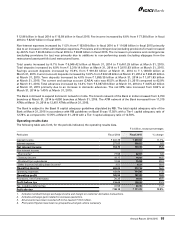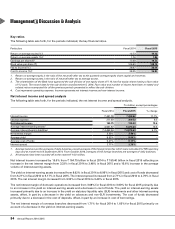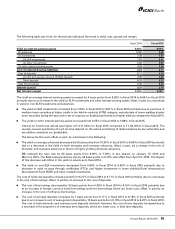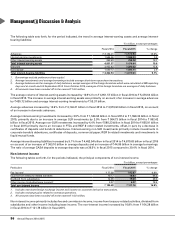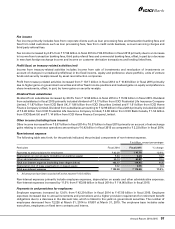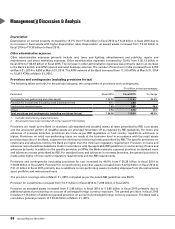ICICI Bank 2015 Annual Report Download - page 90
Download and view the complete annual report
Please find page 90 of the 2015 ICICI Bank annual report below. You can navigate through the pages in the report by either clicking on the pages listed below, or by using the keyword search tool below to find specific information within the annual report.
88 Annual Report 2014-2015
BUSINESS ENVIRONMENT
Global growth was 3.4% during calendar year (CY) 2014, similar to CY2013. Growth in the United States improved to 2.4%
in CY2014 compared to 2.2% in CY2013. Growth in the Euro Area and Japan, however, continued to remain subdued.
There was a slowdown in economic growth in emerging market economies. China’s economy grew by 7.4% in CY2014
compared to 7.8% in CY2013. Monetary policies were divergent across economies during the year. While the United
States withdrew quantitative easing in 2014, the Euro Zone and Japan expanded their monetary easing programmes. A
key highlight during the year was the sharp decline in commodity prices, particularly of crude oil. The price of benchmark
Brent crude fell from USD 108/barrel in the beginning of fiscal 2015 to USD 55/barrel by end-March 2015.
In India, the formation of a stable government with a strong electoral mandate in May 2014 led to an improvement in
market sentiment. There was recovery in key economic parameters during the year. Economic growth improved, inflation
moderated, the current account deficit and exchange rates remained stable and interest rates came down during the
year. The corporate investment cycle continued to remain subdued; the focus remained on working towards cashflow
generation from existing projects and addressing profitability and liquidity challenges in the corporate and SME sectors.
The government has taken several steps to improve the operating environment and also announced several reforms.
These measures are expected to positively influence economic conditions going forward.
In fiscal 2015, the Central Statistical Organisation (CSO) introduced a new methodology for calculation of Gross Domestic
Product (GDP) and also revised the base year from fiscal 2005 to fiscal 2012. Notable changes in the methodology included
replacing GDP at factor cost with GDP at market prices as the official GDP estimate. The sector-wise break-up of GDP is
now represented by Gross Value Added (GVA) at market prices. As per the revised methodology, India’s GDP grew by 7.4%
during the first nine months of fiscal 2015 compared to a growth of 7.0% in the corresponding period of fiscal 2014. Private
consumption recorded a growth of 5.4% and investments, as measured by gross fixed capital formation, grew by 3.9%
during the first nine months of fiscal 2015, compared to a growth of 5.9% in private consumption and 4.7% in investments
during the first nine months of fiscal 2014. Government expenditure grew by 9.7% during the first nine months of fiscal
2015 compared to an increase of 14.0% in the corresponding period of fiscal 2014. On GVA basis, the agriculture sector
grew by 1.4%, industrial sector by 5.3% and services sector by 10.7% during the first nine months of fiscal 2015 compared
to 3.4%, 4.6% and 10.0% respectively, in the corresponding period of fiscal 2014. As a proportion of GVA, agriculture
comprised 17.2%, industry 31.7% and services 51.1% as per the revised estimates. The CSO has estimated GDP growth
for fiscal 2015 at 7.4% compared to 6.9% in fiscal 2014 and 5.1% in fiscal 2013.
Inflation, measured by the Consumer Price Index (CPI), moderated sharply during fiscal 2015 partly supported by the drop
in international crude oil prices. CPI, which was recalibrated to a new base year fiscal 2012 from the earlier base year fiscal
2010, eased from 8.3% in March 2014 to 5.2% in March 2015. Food inflation dropped from 8.6% in March 2014 to 6.2% in
March 2015, housing inflation eased from 12.7% to 4.8%, and services inflation from 6.4% to 3.0% during the period. Core
CPI inflation, excluding food and fuel, reduced significantly from 8.0% in March 2014 to 3.8% in March 2015. The average
CPI inflation for fiscal 2015 was 6.0%.
In the first bi-monthly monetary policy review for fiscal 2015, the Reserve Bank of India (RBI) had articulated an
inflation target of 8.0% by January 2015 and 6.0% by January 2016. During fiscal 2015, RBI remained focused on the
inflation trend and accordingly the repo rate was kept unchanged at 8.0% during the first nine months of fiscal 2015.
RBI announced a 25 basis points reduction in the repo rate from 8.0% to 7.75% on January 15, 2015 and another
25 basis points reduction to 7.50% on March 4, 2015. In March 2015, RBI entered into a monetary policy framework
agreement with the Government of India wherein the RBI would pursue a target of bringing down the inflation level
below 6.0% by January 2016 with the target for fiscal 2017 and all subsequent years set at 4.0% (with a band of
+/- 2%). Further, RBI reduced the statutory liquidity ratio (SLR) by an aggregate 150 basis points from 23.0% to 21.5%
during fiscal 2015, with 50 basis points reduction each in June 2014, August 2014 and February 2015. The ceiling
for inclusion of government securities forming part of SLR in the held-to-maturity (HTM) category was reduced from
24.5% of net demand and time liabilities (NDTL) to 24.0% of NDTL in August 2014. In September 2014, RBI announced
a further reduction in the ceiling on SLR securities under the HTM category to 22.0% of NDTL with a phased reduction
of 50 basis points each in January 2015, April 2015, July 2015 and September 2015. RBI continued to reduce the
access of banks to the Liquidity Adjustment Facility (LAF) window. On April 1, 2014, access to liquidity through LAF
was reduced from 0.50% of NDTL to 0.25% of NDTL. Correspondingly, liquidity through 7-day and 14-day term repos
was increased from 0.50% of NDTL to 0.75% of NDTL.
Management’s Discussion & Analysis

















